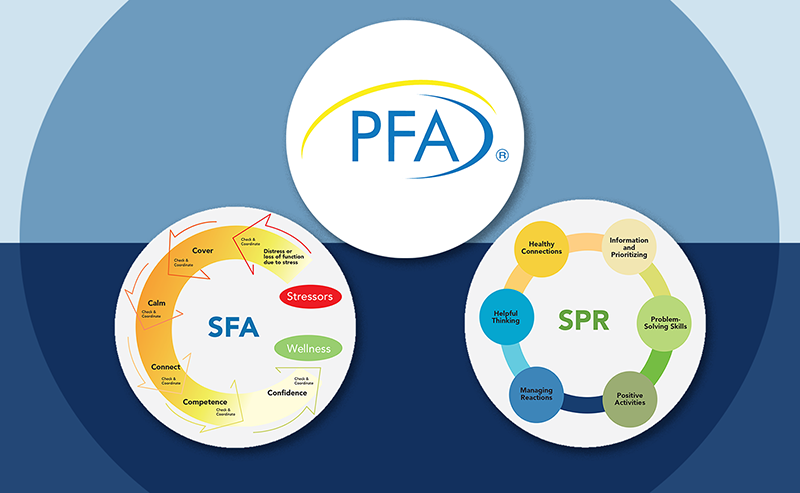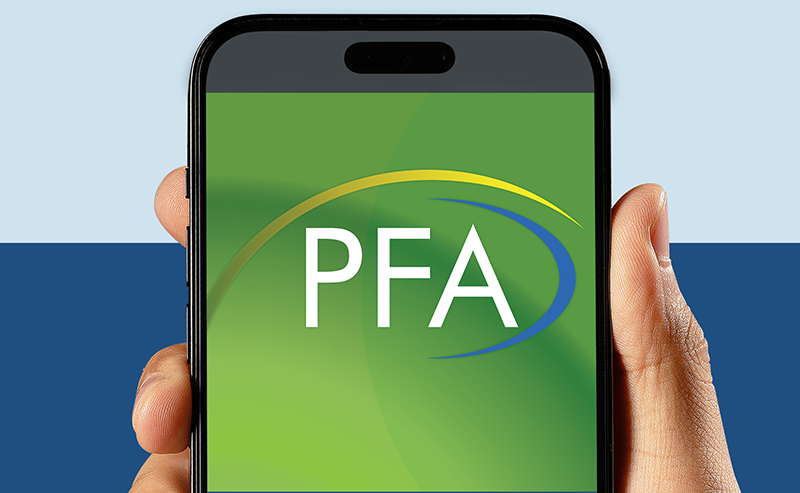PTSD: National Center for PTSD
Intermediate Treatment Interventions Following Disaster Events
Intermediate Treatment Interventions Following Disaster Events
The intermediate phase of psychosocial support usually occurs in the weeks to months following disaster events, which can be natural or human-caused disasters, mass violence, or public health emergencies like disease outbreaks, chemical spills, or radiation emergencies. In the immediate aftermath of these events, people who are exhibiting debilitating or protracted reactions may need additional help.
Interventions during the intermediate stage focus on providing supportive counseling, connecting affected individuals with resources, teaching resilience-enhancing strategies and, finally, assessing and providing intensive formal treatment for those at highest risk for ongoing problems.
This differs from the early phase, when the provision of practical support or psychosocial interventions like Psychological First Aid (PFA) are sufficient for the majority of those who are distressed or having trouble functioning. See Early Interventions Following Disaster and Mass Violence for more information on supporting survivors in the early post-event phase.
In This Article
Improving Access to Care
One of the most significant challenges to provision of psychosocial support following disasters and mass violence is that affected individuals do not seek mental health care or use available services, even when significantly distressed (1-7). Particularly in the intermediate phase after the event, affected individuals may resist getting care for many reasons.
For example, they may be unfamiliar with the concept of mental health outreach, and therefore feel that such efforts are intrusive. They may be reluctant to discuss experiences or thoughts that might bring up uncomfortable feelings, especially with someone they have only recently met. Even if they are willing to talk, they may have difficulty thinking through and explaining what they have experienced. And finally, some affected individuals may compare themselves to their neighbors and don't think they need or deserve as much help as others do. Others may attempt to "handle things on their own" for a period of time before realizing the benefit of seeking assistance.
A number of specific strategies used by crisis counselors in the FEMA-funded crisis counseling program, or by individuals working for local non-profit or community mental health agencies have shown promise in countering barriers to care:
- Providing outreach not just to those directly affected by disasters and violence, but also service providers and systems that could benefit from knowing about resources and how to support affected individuals. These service providers and systems could include spiritual leaders, school personnel, first responders, public health and medical professionals, employee assistance programs, and volunteers (e.g., 8,9).
- Providing information about how psychosocial interventions have been tailored to be applicable to the particular event, as well as to local community and ethnocultural factors (e.g.,10-12).
- Providing technology such as mobile apps, telehealth, and online treatment in the delivery of evidence-based and evidence-informed treatment. These measures have shown some promise in reaching more people as well as reducing distress, in disaster and mass violence settings (e.g., 13-18).
Intermediate Phase Interventions
Another important way to overcome some of the barriers to care following disasters is to offer interventions that are based on building skills and resilience, which are able to be tailored to the person's priorities and needs. These types of interventions show promise in helping individuals reduce distress, reduce the need for more intensive interventions, and improve functioning (19-28).
Skills for Psychological Recovery (SPR) is one example of this type of intervention. It was developed by the National Center for PTSD and the National Child Traumatic Stress Network (19). SPR can be a key next step after the Psychological First Aid actions that are offered soon after disaster or mass violence.
Because many people don't think of themselves as needing a "mental health" intervention after a disaster, SPR allows helpers to empower people to be more effective at managing their own problems and reactions. It was designed to bolster survivors' natural abilities to cope with common post-disaster problems and reactions. More directive and educational than supportive counseling, SPR uses a modular approach that can be deployed in one contact or across multiple sessions.
Its six core actions incorporate strategies from evidence-based cognitive-behavioral treatments for depression, anxiety, and PTSD:
- Information gathering and prioritizing assistance.
In collaboration with the affected individuals, the SPR provider determines which SPR skills on which to focus. The affected individuals begin to identify and organize their priorities and needs, and make a plan to address those needs. - Building problem-solving skills.
In this core action, people learn how to break down problems into more manageable steps, come up with a variety of possible solutions, choose what to do in a thoughtful way, and make a plan to follow through. In post-disaster settings or after mass violence, providing a structured way to come up with solutions to problems can reduce affected individuals' sense of being overwhelmed, and increase their sense of coping self-efficacy and empowerment. - Promoting positive activities.
In situations of high stress, affected individuals tend to forget—or feel like it's not possible—to deliberately schedule these activities into their lives. Scheduling positive and rewarding activities into their lives in a deliberate way helps people improve their energy level, sense of control, and mood. - Managing reactions to stress and reminders.
Individuals learn how to better deal with upsetting physical and emotional reactions, and to put words to experiences to better understand and manage their distress. These skills are often needed before any of the other skills are possible. - Promoting helpful thinking.
This core action encourages people to identify what they are saying to themselves about themselves, their experience of the event, or their current situation, and to choose more helpful ways of thinking. Helpful thinking is not the same as positive thinking. What the person is thinking may be understandable in the context of their experience, but spending less time focusing on unhelpful thoughts and more on helpful ones can mobilize and energize them even in the middle of a stressful situation. - Rebuilding or fostering healthy social connections.
This core action focuses on social support. Individuals are encouraged to identify who is in their social network, improve existing positive connections, reduce contact with people who are less helpful, and create new healthy connections.
SPR is meant to provide practical assistance with skills that have been shown to help individuals overcome a variety of problems following disasters and mass violence. SPR can be taught to large groups of lay providers relatively rapidly and delivered by paraprofessionals in a variety of settings. Because it was designed to be a model that can be used by lay professionals, it does not include more complex formal mental health interventions. It can, however, provide a conduit to formal mental health treatments for those who may be experiencing significant long-term distress and trouble functioning.
For more information about these interventions, see:
References
- Elhai, J. D., & Ford, J. D. (2009). Utilization of healthcare services after disasters. In Y. Neria, S. Galea, & F. Norris (Eds.), Mental health consequences of disasters (366-386). NY: Cambridge University Press.
- Lowe, S. R., Fink, D. S., Norris, F. H., & Galea, S. (2015). Frequencies and predictors of barriers to mental health service use: A longitudinal study of Hurricane Ike survivors. Social Psychiatry and Psychiatric Epidemiology, 50, 99-108. doi:10.1007/s00127-014-0908-y
- Goldmann, E., & Galea, S. (2014). Mental health consequences of disasters. Annual Review of Public Health, 35, 169-183. doi:10.1146/annurev-publhealth-032013-182435
- O'Donnell, M.L., Lau, W., Tipping, S., Holmes, A.C.N., Ellen, S., Judson, R., ...& Forbes, D. (2012). Stepped early psychological intervention for posttraumatic stress disorder, other anxiety disorders, and depression following serious injury. Journal of Traumatic Stress, 25, 125-133. doi:10.1002/jts.21677
- Shalev, A. Y., Ankri, Y. L. E., Israeli-Shalev, Y., Peleg, T., Adessky, R. S., & Freedman, S. A. (2012). Prevention of posttraumatic stress disorder by early treatment: Results from the Jerusalem Trauma Outreach and Prevention Study. Archives of General Psychiatry, 69, 166-176. doi:10.1001/archgenpsychiatry.2011.127
- Zatzick, D. F., Rivara, F. P., Jurkovich, G. J., Russo, J. E., Trusz, S. G., Wang, J., . . . & Katon, W. J. (2011). Enhancing the population impact of collaborative care interventions: Mixed method development and implementation of stepped care targeting posttraumatic stress disorder and related comorbidities after acute trauma. General Hospital Psychiatry, 33, 123-134. doi:10.1016/j.genhosppsych.2011.01.001
- Wade, D., Forbes, D., Nursey, J., & Creamer, M. (2012). A multi-level framework to guide mental health response following a natural disaster. Bereavement Care, 31, 109-113. doi:10.1080/02682621.2012.740285
- Fu, C., & Underwood, C. (2015). A meta-review of school-based disaster interventions for child and adolescent survivors. Journal of Child & Adolescent Mental Health, 27, 161-171. doi:10.2989/1728-583/17280583.2015.11117978
- Boscarino, J. A., Adams, R. E., Foa, E. B., & Landrigan, P. J. (2006). A propensity score analysis of brief worksite crisis interventions after the World Trade Center disaster: Implications for intervention and research. Medical Care, 44, 454-462. doi:10.1097/01.mlr.0000207435.10138.36
- Bryant, R. A., Ekassawin, S., Chakkraband, M. L. S., Suwanmitri, S., Duangchun, O., & Chantaluckwong, T. (2011). A randomized controlled effectiveness trial of cognitive behavior therapy for post-traumatic stress disorder in terrorist-affected people in Thailand. World Psychiatry, 10, 205-209. doi:10.1002/j.2051-5545.2011.tb00058.x
- Marsella, A. J., Johnson, J. L., Watson, P., & Grycznski, J. (Eds.). (2007). Ethnocultural perspectives on disaster and trauma: Foundations, issues, and applications. New York, NY: Springer Science & Business Media.
- Rosen, C. S., Greene, C. J., Young, H. E., & Norris, F. H. (2010). Tailoring disaster mental health services to diverse needs: An analysis of 36 crisis counseling projects. Health & Social Work, 35, 211-220. doi:10.1093/hsw/35.3.211
- Ruggiero, K. J., Price, M., Adams, Z., Stauffacher, K., McCauley, J., Danielson, C. K., ... & Resnick, H. S. (2015). Web intervention for adolescents affected by disaster: Population-based randomized controlled trial. Journal of the American Academy of Child & Adolescent Psychiatry, 54, 709-717. doi:10.1016/j.jaac.2015.07.001
- Steinmetz, S. E., Benight, C. C., Bishop, S. L., & James, L. E. (2012). My Disaster Recovery: A pilot randomized controlled trial of an internet intervention. Anxiety, Stress & Coping, 25, 593-600. doi:10.1080/10615806.2011.604869
- Reifels, L., Bassilios, B., & Pirkis, J. (2012). National telemental health responses to a major bushfire disaster. Journal of Telemedicine and Telecare, 18, 226-230. doi:10.1258/jtt.2012.110902
- Ebert, D. D., Berking, M., Cuijpers, P, Lehr, D., Pörtner, M., & Baumeister, H. (2015). Increasing the acceptance of internet-based mental health interventions in primary care patients with depressive symptoms. A randomized controlled trial. Journal of Affective Disorders, 176, 9-17. doi:10.1016/j.jad.2015.01.056
- Başoğlu, M., Şalcioğlu, E., & Livanou, M. (2007). A randomized controlled study of single-session behavioural treatment of earthquake-related post-traumatic stress disorder using an earthquake simulator. Psychological Medicine, 37, 203-213. doi:10.1017/S0033291706009123
- Difede, J., Cukor, J., Jayasinghe, N., Patt, I., Jedel, S., Spielman, L., ...& Hoffman, H. G. (2007). Virtual reality exposure therapy for the treatment of posttraumatic stress disorder following September 11, 2001. Journal of Clinical Psychiatry, 68, 1639-1647. doi:10.4088/jcp.v8n1102
- Berkowitz, S. J., Stover, C. S., & Marans, S. R. (2010). The Child and Family Traumatic Stress Intervention: Secondary prevention for youth at risk of developing PTSD. Journal of Child Psychology and Psychiatry, 52, 676-685. doi:10.1111/j.1469-7610.2010.02321.x
- Vernberg, E. M., Hambrick, E. P., Cho, B., & Hendrickson, M. L. (2016). Positive psychology and disaster mental health: Strategies for working with children and adolescents. Journal of Clinical Psychology, 72, 1333-1347. doi:10.1002/jclp.22289
- Hansel, T. C., Osofsky, H. J., Steinberg, A. M., Brymer, M. J., Landis, R., Riise, K. S., ... & Speier, A. (2011). Louisiana Spirit Specialized Crisis Counseling: Counselor perceptions of training and services. Psychological Trauma: Theory, Research, Practice, and Policy, 3, 276-282. doi:10.1037/a0024644
- Wade, D., Crompton, D., Howard, A., Stevens, N., Metcalf, O., Brymer, M., ... & Forbes, D. (2014). Skills for Psychological Recovery: Evaluation of a post-disaster mental health training program. Disaster Health, 2, 138-145. doi:10.1080/21665044.2015.1085625
- Fletcher, S., Creamer, M., & Forbes, D. (2010). Preventing post traumatic stress disorder: Are drugs the answer? Australian and New Zealand Journal of Psychiatry, 44, 1064-1071. doi:10.3109/00048674.2010.509858
- Rosen, C. S., Matthieu, M. M., & Norris, F. H. (2009). Factors predicting crisis counselor referrals to other crisis counseling, disaster relief, and psychological services: A cross-site analysis of post-Katrina programs. Administration and Policy in Mental Health and Mental Health Services Research, 36, 186-194. doi:10.1007/s10488-009-0216-0
- Forbes, D., O'Donnell, M., & Bryant, R. (2016). Psychosocial recovery following community disasters: An international collaboration. Australian & New Zealand Journal of Psychiatry, 7, 660-662. doi:10.1177/0004867416679737
- Dawson, K., Joscelyne, A., Meijer, C., Steel, Z., Silove, D., & Bryant, R. A. (2017). A controlled trial of trauma-focused therapy versus problem-solving in Islamic children affected by civil conflict and disaster in Aceh, Indonesia. Australian & New Zealand Journal of Psychiatry, 52, 253-261. doi:10.1177/0004867417714333
- Sijbrandij, M., Bryant, R. A., Schafer, A., Dawson, K. S., Anjuri, D., Ndogoni, L., ... & van Ommeren, M. (2016). Problem Management Plus (PM+) in the treatment of common mental disorders in women affected by gender-based violence and urban adversity in Kenya; study protocol for a randomized controlled trial. International Journal of Mental Health Systems, 10, 44. doi:10.1186/s13033-016-0075-5
- Reifels, L., Bassilios, B., Forbes, D., Creamer, M., Wade, D., Coates, S., ... & Pirkis, J. (2013). A systematic approach to building the mental health response capacity of practitioners in a post-disaster context. Advances in Mental Health, 11, 246-256. doi:10.5172/jamh.2013.11.3.246
You May Also Be Interested In


























